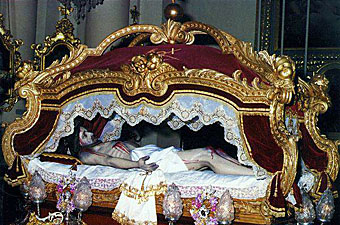Graven Words
“Catholics do not worship idols, it would be a mortal sin if they did.”
Apparently there is a difference between veneration and worship? That is their argument.
I agree that the common argument against it is a bit weak, but James Jordan writes:
“This commandment is often misinterpreted as stating that no picture of God can be made. This is not what it says. What is says is that no image of anything can be set up as an avenue of worship to God and the court of heaven… Thus, the idea is not that of a “graven” image as opposed to a “molten” image or a “painted” image. The idea is that of a manmade graven object versus the God-made graven Word. The opposition is between God’s content-filled graven Words and man’s silentgraven images. The opposition of God’s verbal covenant and man’s graven images is set out in greater detail in Deuteronomy 4:15-31.”
We are not to meditate on images but on God’s Words. And besides that, as it plays out in practice, veneration just ends up as idol worship, whatever you decide to call it. A spade is a spade.
“God commanded Moses to make graven images, so it’s fine for Catholics to venerate images as long as they are of God.”
Moses was commanded to make the cherubim and the bronze serpent. These were all objects with the purpose of educating the people of God in their childhood. The law was a schoolmaster to bring us to Christ.
Even during the restoration period, the cherubim and the ark were absent, and the physical Temple was being superseded by a building made of people (seen by Ezekiel). With the New Covenant, this arrived in full. All the childish object lessons and symbols were done away with.
These verses in Galatians 4 could apply to the Roman church as much as to the Judaisers of the first century:
Galatians 4:3 Even so we, when we were children, were in bondage under the elements of the world.
Galatians 4:9 But now after you have known God, or rather are known by God, how [is it that] you turn again to the weak and beggarly elements, to which you desire again to be in bondage?
Where did Christ command images to be made of Him or the apostles? He is our wisdom and maturity. We have no need of God’s flannelgraph any more. It decayed and vanished away, and there is evidence that this is exactly what the NT writers referred to by the word elements (stoicheia). They are always regarded negatively. These weak and beggarly elements would be burned with fire (2 Peter 3:12 taken in its correct context – the destruction of Herod’s Temple).
Time for the Roman church to put away the magical toys and trinkets.
Show me where he commanded cathedrals, pastoral staffs, communion tables, stained glass windows, with Apostles and Our blessed Lord depicted rent free vicarages, clerical collars, surplices, cathedral choirs, liturgical prayer books. etc
These things are often wrongly considered to be ‘holy.’ While I believe that church architecture, furniture, liturgy, etc. should show a great degree of honour towards God and the importance of our worship, whenever these things have been considered holy in and of themselves, the church has been in error. The fact that the New Covenant church can function perfectly without any of these things is testimony to their periphery. The real issue here is prostration.
Regarding the second commandment again, Jordan writes:
“It is impossible to separate the command “You shall not prostrate to them” from what precedes. If it were an additional, coordinate thought, it would begin with “and.” Thus, it is wrong to isolate the first command and say that God forbad the Israelites to make any images of any created thing, period. After all, the Tabernacle and Temple were full of images. The focus of the command is on prostrating to and serving images.”
Quotes from Hearing, Seeing and History by James B. Jordan


























